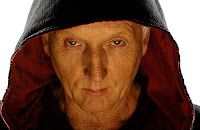Both are equally scarring, un-enjoyable, and take days to forget.

I understand why the league does it: to thank their sponsors and to promote their star players. Both aspects are vital to any company’s survival and growth, so it’s not like the festivities are going away any time soon. But the entire event, the game, the skills competition, the introductions, the surrounding failed attempts at "hype", has all become intolerable.
I used to love the All-Star game. I remember really looking forward to it. I not only sat through those 11-5, 10-6, and 16-6 games in the early 90’s…I loved them. Seeing all the best players in hockey on the ice at the same time, Gretzky, Lemieux, Yzerman, was almost mind-boggling. Watching the way everyone interacted with one another, identifying which players were leaders, who the jokers were, and who had the hardest shot or best accuracy…these were intriguing storylines that made for compelling television. It was great entertainment and was eagerly anticipated from this corner.
But somehow over the last decade or so, everything changed.
When I look back now, I see three primary reasons why the All-Star game has gone (for me personally) from can’t miss to can’t watch.
1) We grow up. As kids we like the players, we have our favorites, we collect the hockey cards and we devote most of our attention to the biggest stars. As we get older, our fan maturity kicks-in and the priority changes from individual accomplishment to team success. (Or lack thereof in the case of Leaf fans.)

2) Intensity. It seems to be on an indefinite suspension (much like Sean Avery, only he has a better chance of returning). I think the lack of intensity is caused by the fact that salaries have increased so rapidly and to such a degree that players no longer, as a whole, have the collective passion their predecessors had and therefore treat exhibitions as true exhibitions. Make no mistake, even the now mailing-it-in actors Robert De Niro and Al Pacino put more effort into their performances than NHL All-Stars do.
3) Technology. With the number of local and national games that are televised, round-the-clock highlights, the plethora of information and video available on the internet, and the option of buying the NHL Center Ice package, fans today are more connected to the NHL than we’ve ever been. We can follow anyone and everyone as closely as we desire. Instead of catching glimpses of the best here and there and watching them congregate only once annually in the form of an All-Star game, we now see them nightly in double-headers, highlight packs, and fantasy recaps. The mystery that once surrounded players on teams outside our own division or conference has disappeared.
These three factors work together to create an All-Star weekend that features an incredibly lame skills competition (where players, if they agree to show-up, look bored, confused, or both) and a lifeless game of some sport that is indeed played on ice, but most assuredly is not NHL hockey.
This shouldn’t be misconstrued as a singular attack on the NHL. It’s more of a shot directed at all sports, because each of their so-called All-Star festivities are more Jared Leto than Jennifer Connelly. The Pro Bowl has never mattered, the NBA’s version faces many of the same problems that hockey’s does (no defence and a stale, unimaginative skills competition), and baseball’s game, while easily the closest to actual regular season quality, is reduced by the parade of pitchers and players that enter and exit seemingly by the moment, and the overwhelming boringness of the Home Run Derby. They all have issues that need to be addressed and corrected in order to make the events relevant and watchable for their fans.
Except the CFL, which actually has the best of the bunch.
Theirs doesn’t exist…















